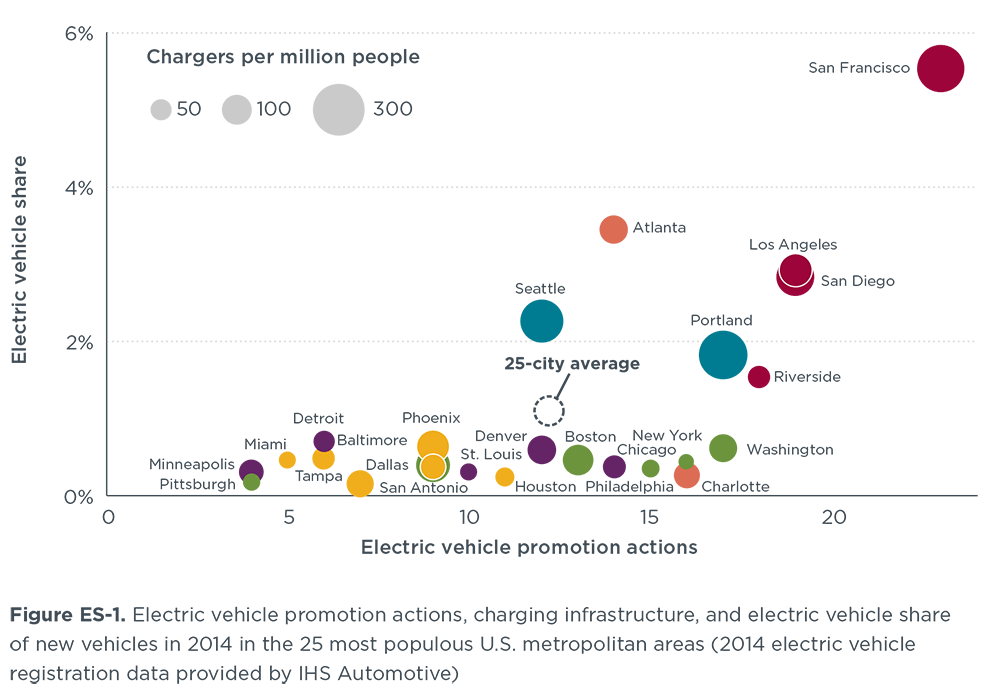Electric vehicle markets have their ups and downs (2014 YTD update)
Blog
Electric vehicles rising, in select US cities
Are electric vehicle sales in the doldrums, or are they skyrocketing? If you follow enough of the news, you’ll see stories arguing both of those opposing conclusions. This is part of what makes tracking electric vehicle trends fun. And it also highlights the point that, considering all the diverse local electric vehicle activity, understanding the underlying market development with greater granularity is important.
Electric vehicle incentives differ across states, and new promotion efforts, like this latest with West Coast Electric Fleet initiative, keep sprouting up. Public charging infrastructure also varies greatly across the U.S. Automakers’ model availability and their contrasting rollout strategies (e.g., Kia, BMW and VW, GM) to a large extent dictate the early market growth too. With all these differences, we figured that digging deeper—down to the local level—could help illuminate what is really happening across markets and which actions are connected to electric vehicle sales.
So we sought to analyze all the data we could get our hands on to see what is driving electric vehicle uptake. We built upon our earlier US state-level study to also analyze city actions—specifically, at the “metropolitan statistical areas” level. We compiled 2014 electric vehicle sales data, and what policy actions were in play across the cities. Early on, we started to see where the battery electric and plug-in hybrid sales are higher, then we layered on an understanding of the public charging infrastructure. In our latest paper, we report on all the other activities: consumer subsidies, non-financial incentives, outreach and information activities, and utility promotion activities.
Broadly, it is clear that major cities are important hubs with many diverse electric vehicle promotion actions and a disproportionate share of electric vehicle deployment. Across the 25 cities in the study, there was an average of a dozen such electric vehicle promotion activities. Electric vehicle sales in the 25 cities were on average 40% greater than the nationwide electric vehicle share, and the 25 cities accounted for over 80,000 new electric vehicles in 2014, or over two thirds of all US electric vehicle sales.
Seven cities stand out for their higher electric vehicle sales. San Francisco, Atlanta, Los Angeles, San Diego, Seattle, Portland, and Riverside had 2 to 7 times the electric vehicle uptake of the US average. The figure below illustrates the share of new 2014 light-duty vehicles that are plug-in electric vehicles, across the 25 major U.S. metro areas. The figure compares new electric vehicle share (on the vertical axis) with electric vehicle promotion activities (horizontal axis) and public charger infrastructure (the size of the circles). The colors link cities that are in the same region of the country. The figure is based on the analysis of 30 state, city, and utility actions taken to promote electric vehicles and the per capita charging infrastructure in each area. As shown, there is great variation across the metropolitan areas, and San Francisco exhibits the most electric vehicle promotion actions and the highest share of new vehicles that are plug-in electric.
What are the key findings? First, government policy is clearly important in driving electric vehicle deployment. Cities with the highest electric vehicle shares tend to be located in states that have joined in the Zero Emission Vehicle program and also have consumer incentives. Various cities are leading in different ways – some with more direct incentives, charging infrastructure, some with more outreach and awareness activity, and other with utility support for electric vehicle users. For example, for Atlanta incentives were the thing; for Portland, public charging and outreach are working; California cities have a more comprehensive package of activities by many actors. Generally we realized that model availability appears to holding back electric vehicle sales in many of the markets. We also found that there are important further lessons still to learn from smaller U.S. cities that are outside the study’s scope.
We continue to work with our collaborators at the 11th Hour Project, C2ES, C40 Low Emission Vehicle network, UC-Davis ZE MAP, and many city and state practitioners to extend the learning process and identify best practices.
For now, though, it’s safe to conclude the electric vehicle market is definitely not in the doldrums, and it is surely on the rise, at least in several leading locales.

